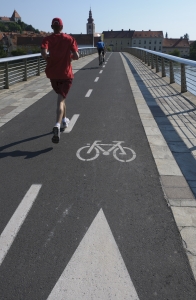While total knee replacement surgery is primarily done in older patients who have suffered years of arthritis, there is another group of patients who might be in need of an artificial knee joint. This group consists of younger athletes and those who may not even be athletes, but frequently engage in running activities such as races, marathons and triathlons.
 For many of these people who are experiencing knee pain, there is a fear of going to a doctor. Their fear is based upon a belief their doctor will tell them they need a knee replacement, and after they get one, they will never be able to run again, because an artificial joint was not designed for repeated impact of regular running.
For many of these people who are experiencing knee pain, there is a fear of going to a doctor. Their fear is based upon a belief their doctor will tell them they need a knee replacement, and after they get one, they will never be able to run again, because an artificial joint was not designed for repeated impact of regular running.
As discussed in a recent news article from the San Francisco Examiner, doctors who frequently work with patients who enjoyed running believe every year a patient can get out of their natural knee, the better. This does not mean dealing with pain until it becomes unbearable, but rather trying less invasive surgical techniques short of total knee replacement. Some of these techniques include arterial cartilage paste grafting and rebuilding a patient’s damaged meniscus or replacing it without replacing the entire knee joint. This is sometimes known as a reconstruction or partial knee replacement. Robotic surgical techniques can be used to perform a series of less invasive replacements of individual knee components. This is in contrast to the traditional advice, which is often to do nothing until the pain becomes too bad to handle after years of further deterioration.
Another way to improve one’s prognosis and still be able to run and do other exercise is work on strengthening the leg muscles surrounding the knee, which reduce the amount of strain put on the joint.
Interestingly, some research suggests the total wear and tear on an artificial knee joint or a patient’s natural knee depends more on distance covered than whether he or she is running or walking. While this may seem strange at first, since there is more impact exerted on knee joints when a person in running, it takes less steps to run a mile than it does to walk a mile. When you calculate the total impact on the knee, it may be equal in terms of few strides while running and more strides while walking.
While this may provide a promising outlook for athletes facing a partial or total knee replacement, there are sure to be problems if the artificial knee joint is defectively designed, as our Boston knee replacement injury attorneys have seen all too often.
If you have had a total knee replacement and are told you need to have another surgery to repair or replace a defective knee, you should contact an experienced attorney as soon as possible. A properly constructed artificial knee is supposed to last between 10 and 20 years. Unfortunately, defectively designed knees are failing anywhere from immediately after implantation to a few years after surgery. Absent a traumatic injury, this shouldn’t happen, and you may have valid claim against the manufacturer.
If you are the victim of a defective medical device in Boston, call Jeffrey Glassman Injury Lawyers for a free and confidential appointment — (617) 777-7777.
Additional Resources:
Total joint replacement for athletes , April 19, 2015, SF Examiner
More Blog Entries:
FDA Announces Testosterone Meds Must Carry Broader Warning, July 7, 2014, Boston Products Liability Lawyers Blog
 Product Liability Lawyer Blog
Product Liability Lawyer Blog

